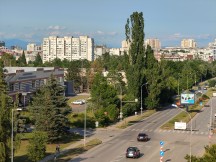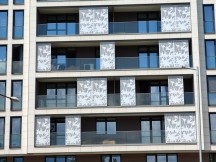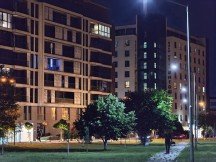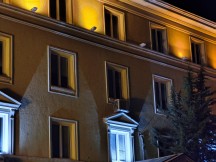ZTE Axon 40 Ultra review

Daylight image quality
Photos from the Humanity camera of the ZTE Axon 40 Ultra are, for the most part, excellent. The 16MP resolution lets it capture a lot of detail, and it's rendered in a fairly natural manner without excessive sharpening. Noise is essentially non-existent.
Color reproduction is generally great, though if you've been conditioned to a warmer and more saturated look, the ZTE images might be a little too restrained for you. We found that to be the case only when shooting food - that salad is pictured to look way too close to reality as opposed to how we like to see salads on Instagram. That's an easy fix in post, of course, and not something we feel is needed in other types of scenes.
Dynamic range is good, though the Axon does prefer a contrasty look which could be taking away some development at the extreme ends. The snail shot is a particularly fine example of that. It helps to enable HDR full time, instead of leaving it in Auto.
For what it's worth, the longer focal length didn't feel limiting or weird in any way.









Daylight samples, main camera (1x)
We mentioned how the Axon's main camera should have some great potential for subject separation and, indeed, it can make detail in backgrounds disappear into a blur. As these things go, the effect is most pronounced the closer you are to your subject and the farther the background is from it. It's not 85mm f/1.4 from your favorite camera system level of bokeh creaminess, but it's a really nice look as smartphones go.
Flipping the AI toggle on made no difference for our test scenes, which is hardly something that bugs us, given the overall likable rendition of color and contrast - the things 'AI' modes typically boost. Then again, the 'Food' scene didn't liven up the salad at all, sad face emoji).









Daylight samples, main camera, AI on
Similarly pointless is the Full Size mode in the Camera-family (the icon for which is a capital 'M', because of... reasons?), which outputs images at the nominal 64MP resolution. To our eyes, these are upscaled 16MP shots with no detail benefit whatsoever. Then again, much like how we feel about the lack of an AI color boost, we're hardly bothered by this outcome.






Daylight samples, main camera, 64MP
The ultrawide camera captures equally great photos - it's among the best ultrawides we've seen when shooting in bright daylight. The detail is excellent, and there's no sharpness falloff towards the corners. Being the same sensor and all, it's a perfect match in color reproduction to the main camera's output. Perhaps a slightly more enthusiastic approach to HDR application could result in a different take on exposure, but that could also be the wider frame metering differently. Impressive results anyway.












Daylight samples, ultrawide camera
Again, no difference with AI on, and no point in shooting full-res.






Daylight samples, ultrawide camera, AI on






Daylight samples, ultrawide camera, 64MP
The telephoto lives up to a high standard too. It's treating us to nicely detailed, sharp shots, which are also noise-free. It can have somewhat of a tendency to underexpose on occasion (snail, castle), but we wouldn't call it an issue. No complaints on color and dynamic range.









Daylight samples, telephoto camera
For completeness' sake, here are the scenes with AI on and then in the full-res mode.






Daylight samples, telephoto camera, AI on






Daylight samples, telephoto camera, 64MP
Low-light image quality
In low light, the Axon does engage some light Night mode processing, as evidenced by an icon with stars that pops up in the corner of the viewfinder, though you can disable that. Even so, these images don't have that Night mode pop we're used to seeing, so you can treat them as Night mode-less.
Indeed, the photos shot this way are generally darker than we'd like, particularly in scenes that are darker, to begin with. The Axon clearly biases its exposures to preserve highlights and doesn't brighten up shadows along with that, so high-contrast scenes will tend to end up too dark. A healthy kick to the shadows slider in your favorite image processing software doesn't hurt them too much, so it leaves us wondering why ZTE isn't doing it in-phone.
We're not entirely impressed with the level of detail we see, however, and a combination of noise reduction and sharpening is leaving these photos looking overprocessed at 1:1. The colors are great, though.













Low-light samples, main camera
Night mode lifts up the shadows and mid-tones considerably and does produce a lot more pleasing results in terms of exposure across most scenes - to our eyes at least. Having said that, some scenes can look overdone - the park shots towards the end of the set.













Low-light samples, main camera, Night mode
The ultrawide camera does an admirable job in low light - as far as ultrawides go. It, too, can be prone to less than ideal shadow development in its attempts to preserve highlights, but in at least moderately decent lighting takes sharp and detailed shots.










Low-light samples, ultrawide camera
When it comes to Night mode, things are somewhat different on the utlrawide camera, compared to the main one. We'd say that as a general rule, the difference between Photo mode and Night mode in terms of overall exposure isn't as dramatic, though Night mode does have an advantage in the way the tonal extremes are developed. Some scenes did benefit a lot more than others, however, the last two in particular. You could read that as inconsistency, but we'd perfectly happy with its output. Ultimately, we'd stick to Night mode on the ultrawide.










Low-light samples, ultrawide camera, Night mode
The telephoto doesn't disappoint either. Particularly dim scenes aren't its forte, but it does manage to protect highlights well and captures plenty of detail.









Low-light samples, telephoto camera
Night mode lifts up the shadows noticeably and attempts to bring down highlights further, though we did see some posterization with some light sources.









Low-light samples, telephoto camera, Night mode
Once you're done with the real-world samples, head over to our Photo compare tool to see how the ZTE Axon 40 Ultra stacks up against the competition.



ZTE Axon 40 Ultra against the Xiaomi 12 Pro and the Galaxy S22 Ultra in our Photo compare tool
Close-ups
The ultrawide camera on the Axon features autofocus, and it's what the phone uses in its 'Macro' mode. It does do a bit of a crop and upscale action and in fact, matches the field of view of the main camera. Hence, per-pixel detail isn't great, but at fit-to-screen level or for sharing around, the tighter framing that gets you more of a small subject in the frame is appreciated.
Portrait mode
The Axon 40 Ultra is big on portraits - after all, its Humanity camera is a lot better suited for shots of...well, humans, thanks to its 35mm focal length than the 24-26mm units on competitors. In fact, you often don't need to use the Portrait mode at all to get that background blur - particularly if you keep a little closer to your subject and/or place them against a distant background. Here's what we mean.
With a background distant enough, you don't need to be that close to your subject at all. Conversely, however, when your subject is close to the background, and you move away from them, you're losing a lot of the separation.
The actual 'Portrait' mode that adds some simulated blur on top of the natural ones works great, too and is pretty adept at separating the subject from the background. It had run-ins with our wood wall paneling, but other than that - pretty impressive results.
Selfies
The price you're paying for not seeing a display cutout for your selfie camera (being an under-display one) is poor-quality selfies. These have all sorts of color casts, limited dynamic range and a general softness and haziness to them.
Sure, it's a technological achievement to be able to take pictures through the display, but if selfies are at all important to you, the trade-off you're getting here is hardly worth it. Then again, if you're not big on selfies and will only use the front camera for the occasional video call, not having a punch hole isn't half bad.
The camera also offers a Portrait mode, too. Not much we can add.
Reader comments
- Jagganatha
- 22 Mar 2023
- 3HV
Whilst I like the 16MP results a lot, we are STILL (after all these years!!!) NOT being shown full sensor resolution results edited from RAW files, & looking at the full resolution jpegs from this quad-Bayer sensor here, I note they are really dr...
- MUTHUKUMARAN
- 15 Mar 2023
- RxE
I use AXON 40 ULTRA SMARTPHONE very nice 👍... Pure full display screen phone .. I really like this phone .. thanks for ZTE





































